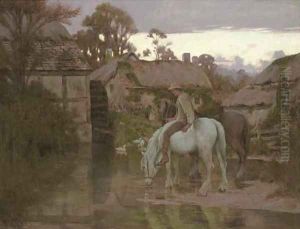Major Godfrey Douglas Giles Paintings
Major Godfrey Douglas Giles was a British artist, known primarily for his equestrian and military subjects, and for his association with the sport of polo. Born on February 1, 1867, in London, England, Giles developed an early interest in military life and horses, which would come to define much of his artistic career.
Giles pursued his artistic training at the Royal Academy Schools, where he honed his skills in painting. His work often depicted scenes of British military life, cavalry, and historical battles, reflecting his deep interest in these subjects. In addition to his paintings, Giles was also recognized for his illustrations, which appeared in various publications of the time.
Beyond his work as an artist, Giles was an avid polo player and became closely connected with the sport. He was instrumental in the development of polo in England, contributing to its popularity and the establishment of rules that are still recognized today. His passion for the game often intersected with his art, as he produced numerous paintings and illustrations that captured the dynamic and aristocratic nature of polo.
Giles served in the military, which further influenced his artwork. His service included time with the Honourable Artillery Company and later with the Queen's Own Oxfordshire Hussars, where he reached the rank of Major. His military experience provided him with an authentic perspective that he translated into his art, imbuing his military subjects with a sense of realism and respect for the armed forces.
Throughout his career, Giles exhibited his work at various venues, including the Royal Academy and elsewhere. His paintings were well-received, and he gained recognition for his ability to portray the movement and grace of horses, as well as the pageantry and drama of military life.
Major Godfrey Douglas Giles passed away on December 24, 1949. Today, his work is remembered for its contribution to the genre of equestrian and military art and provides a valuable historical record of the British military and the sport of polo during the late 19th and early 20th centuries.
